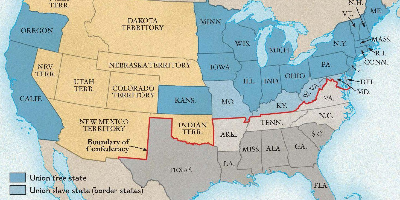Siege of Corinth (29 abr 1862 año – 30 mayo 1862 año)
Descripción:
UNION VICTORYSomething amazing was happening at Pittsburg Landing. Halleck, whose military department was geographically the largest under Federal jurisdiction, was now organizing what would become the young war’s largest military force. He took three armies and merged them into a single unit of more than 100,000 men. The collection of officer talent that led these troops was similarly impressive: In addition to Halleck, Grant, Buell and Pope, there were George H. Thomas, William T. Sherman, William Rosecrans, Phil Sheridan, James B. McPherson, John McClernand, John A. Logan, James A. Garfield, William ‘Bull’ Nelson, Jefferson C. Davis and Lew Wallace.
On April 30, Halleck established three wings of his new army: the Right Wing, under Thomas, consisting of four divisions from the Army of the Tennessee and one division from the Army of the Ohio; the Center Wing, under Buell, consisting of four divisions from the Army of the Ohio; and the Left Wing, under Pope, made up of four divisions from the Army of the Mississippi. The reserve, under McClernand, consisted of two Army of the Tennessee divisions and one from the Army of the Ohio.
Grant became second in overall command. Halleck always insisted that he made this assignment because Grant’s rank required it, but in fact he did not trust Grant and wanted to keep a close eye on him. ‘I never saw a man more deficient in the business of organization,’ Halleck said of Grant. ‘Brave & able in the field, he has no idea of how to regulate & organize his forces before a battle or to conduct the operations of a campaign.’
Facing this massive Union army was P.G.T. Beauregard’s still-recovering Army of Mississippi. After the loss at Shiloh on April 7, it had staggered back to Corinth, leaving scattered along the roads everything from blankets to tent poles, muskets to broken wagons. The original commander, Albert Sidney Johnston, had died in battle, and Beauregard, who had replaced him, had not inspired immediate confidence by ordering an end to the first day’s attack. During that evening Buell had arrived and Grant had reorganized, and the revitalized Union army had swept the Confederates off the field on the second day.
Beauregard recognized how shattered his troops were and called for reinforcements. When the long-awaited Earl Van Dorn with his Army of the West arrived from across the Mississippi River in mid-April, his command consisted of only about 14,000 men. Beauregard added those soldiers to his own 30,000 and scraped together others from all over the Confederacy to create a respectable force of 70,000 with which to face Halleck’s 100,000. Unfortunately for him, nearly 20,000 Confederates were suffering from wounds or disease. Beauregard did, however, have many well-known generals in his officer corps, including Van Dorn, Leonidas Polk, William Hardee, Braxton Bragg, John C. Breckinridge, Mansfield Lovell and Sterling Price.
Corinth, where the Confederate army was entrenched, was not a large city. Incorporated in 1856, it was originally named Cross City because the east-west Memphis & Charleston Railroad and the north-south Mobile & Ohio Railroad were slated to intersect there in the near future. When the Civil War began, Corinth was still a small village with a population of only 1,000. Once the fighting started, the city became a rallying point for troops and supplies. When Albert Sidney Johnston and his army arrived there after the fall of Forts Henry and Donelson in February 1862, the city gained more than 40,000 new military residents, numbers of whom were already ill or became ill and died. Corinth resembled a huge hospital and morgue. Entrenchments protecting the city, begun under Bragg’s direction prior to Shiloh, now stretched into 10 miles of mounded clay and lumber. They reinforced the natural defenses of the swamps and the flooded streams. They ran out of coffins because of the huge number of deaths, but there was always plenty of clay to dig and pile up.
http://www.historynet.com/siege-of-corinth.htm
Añadido al timeline:
fecha:
29 abr 1862 año
30 mayo 1862 año
~ 1 months
